Amid the pandemic, public transit is highlighting inequalities in cities
In the wake of covid-19, how to safely and fully reopen public transportation has become a major point of discussion at both local and federal levels. Much of the conversation so far has focused on logistical challenges like sanitation, overcrowding and lost revenue.
However, public transit directly affects access to different opportunities based on a variety of factors, including riders’ neighborhoods, income levels and now — during the pandemic — whether they can work remotely.
[Editorial board: Why transit must survive the virus]

Commuters step off a bus in Silver Spring, Maryland. (Chip Somodevilla/Getty Images)
These are all issues policymakers will have to consider in their long-term plans. And while underinvestment in transit infrastructure is not new, these inequities to access are being brought to the forefront in the coronavirus era.
'It’s the ripple effects of inequality,' said Ariel Bierbaum, assistant professor of urban studies and planning at the University of Maryland. '[It’s] the exacerbation of inequality at every level.'
The latest Census data from before the pandemic showed that 5 percent of all U.S. commuters typically use public transportation, but in major cities, that number jumps to 10 percent. The rates are much higher for minority groups. Among African American and Asian workers in large cities, almost 1-in-6 use public transit.
The New York metro area has the largest percentage of people who use public transportation to commute to work, followed by San Francisco, Boston and D.C.
[Sign up for our Coronavirus Updates newsletter to track the outbreak. All stories linked in the newsletter are free to access.]
Modes of transportation in metro areas
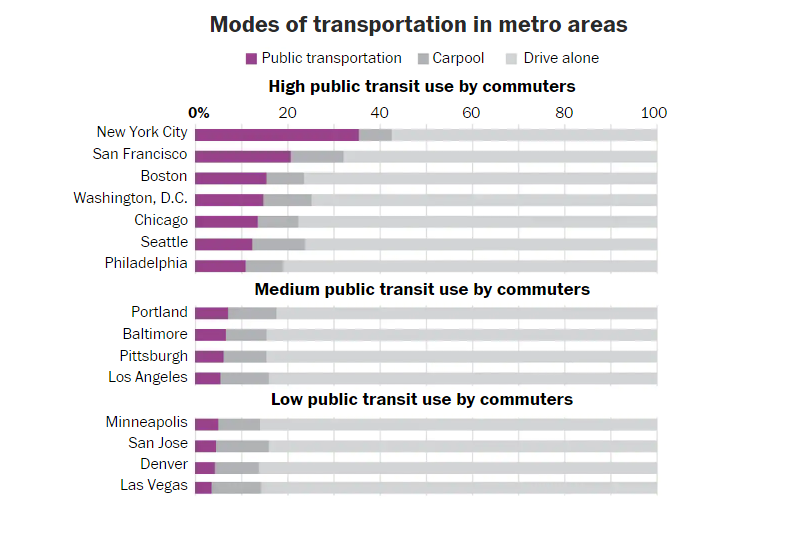
New York has become the center of one of America’s largest outbreaks, with many pointing to the city’s density. However, some experts have been quick to note density itself is not necessarily the problem.
Meli Harvey, an urban planner based in New York City, said density is instead often a “proxy or stand-in” for other factors — like the number of people per household or types of occupations — that may contribute to community transmission in a pandemic.
Using public transit as a lens into inequalities
While people of all income levels use public transportation, a crucial population of people depend on it more than others. Doug Johnson, the transportation planning manager at the San Francisco Planning department, said these riders are often lower-income, minority groups who may not own cars and who rely on transit for access to opportunities like jobs and schools.
Public transportation use by worker earnings
In cities with low overall public transit use, riders with lower income levels make up higher percentages of commuters as they have fewer alternative options compared with those earning higher incomes.

These same people are also disproportionately affected by the current pandemic. A recent study found that counties where residents are predominantly black account for over half of coronavirus cases in the United States and almost 60 percent of deaths. The same study also pointed to socioeconomic factors like employment, access to health insurance and medical care as being predictive of infection and death from covid-19.
Many of these people also hold essential jobs that require them to continue to commute to work and come into contact with others, adding to the likelihood of community transmission.
“They still have to take the bus because they didn’t have another way to get to their service jobs or the hospital or to the grocery store,” said Sean Kennedy, transit planning manager at the SFMTA. “[They] don’t have other options as ways to get around.”
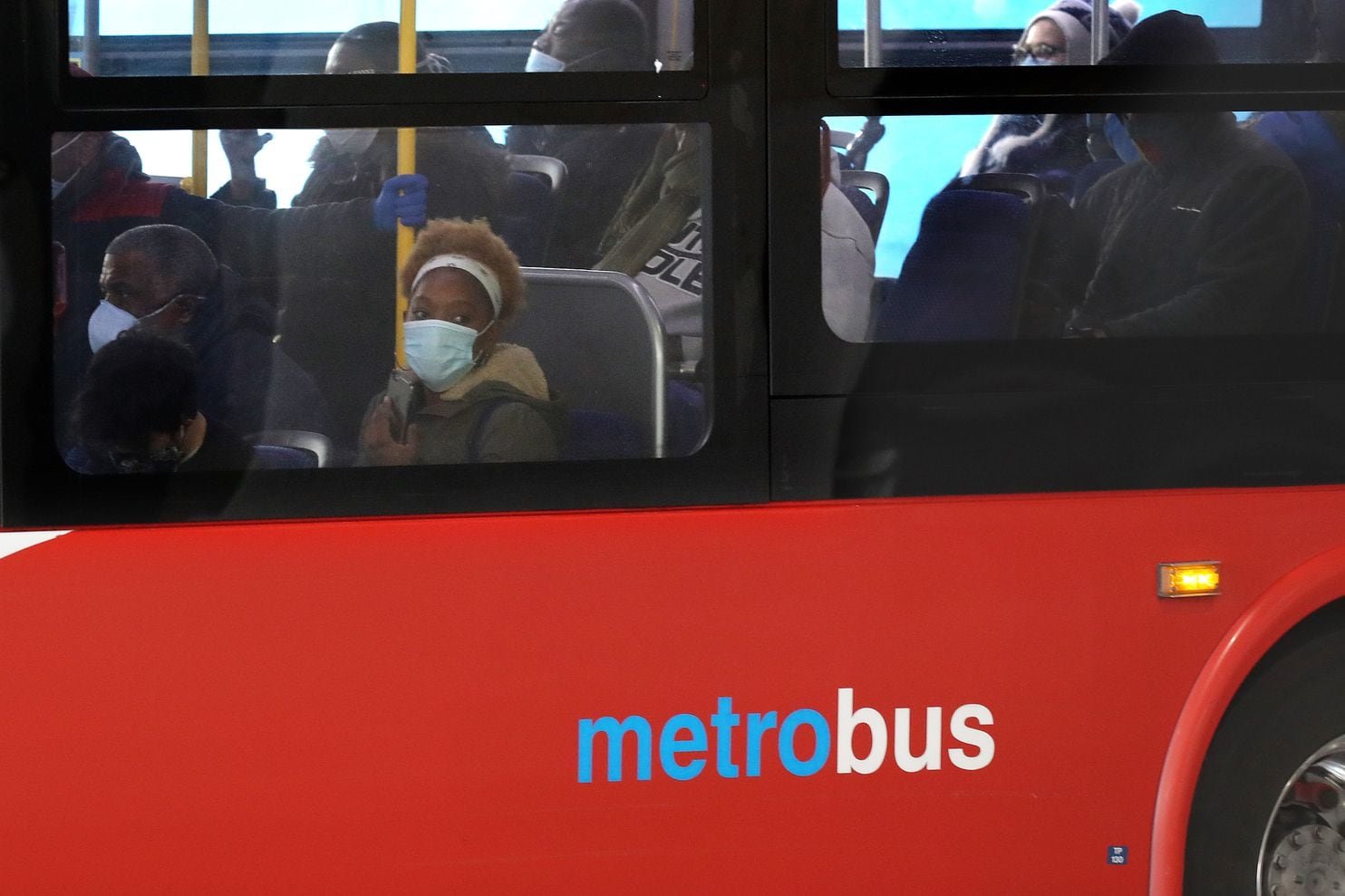
In mid-April, Maryland governor Larry Hogan mandated face coverings when in stores and public transit. (Chip Somodevilla/Getty Images)
Lower-income groups are also some of those most vulnerable to the effects of the coronavirus. A deadly combination of increased exposure and subsequent poor access to health care or sick leave can leave many front line workers in a dangerous position.
“The people who are essential in this economy are people who we have decided are low-wage workers. We haven’t valued them,” Bierbaum said.
[For many ‘essential workers,’ public transit is a fearful ride they must take]
Both high- and low-income workers use public transportation to get to work. However, the key difference is highly-paid workers, like lawyers and software developers, are also more likely to be able to work remotely. More than half of workers in professional and business services reported that they could work from home in 2018. In contrast, less than 10 percent of leisure and hospitality workers (including food workers) had the same flexibility.
Many public transit commuters cannot work from home
Business and finance employees may continue to work from home to avoid commuting by public transportation, but food service and retail workers must do their jobs in person.
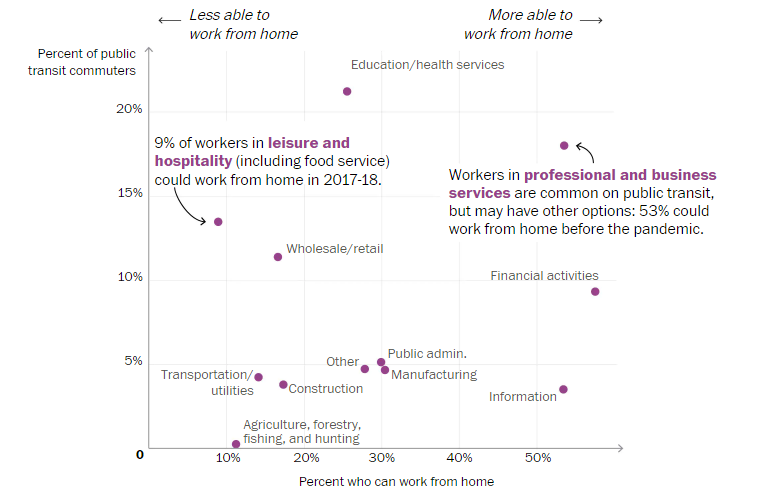
More low-income workers may also have no choice but to use public transportation when required to commute. Workers in lower-paid, service- and transport-based occupations are less likely to have household vehicles than highly-paid workers in finance, technology or legal occupations. For example, among public transit commuters, only one third of home health aides have a household vehicle compared with more than 75 percent of lawyers.
Higher-income workers are more likely to have alternatives to commuting by public transit
30 most common occupations among public transit commuters
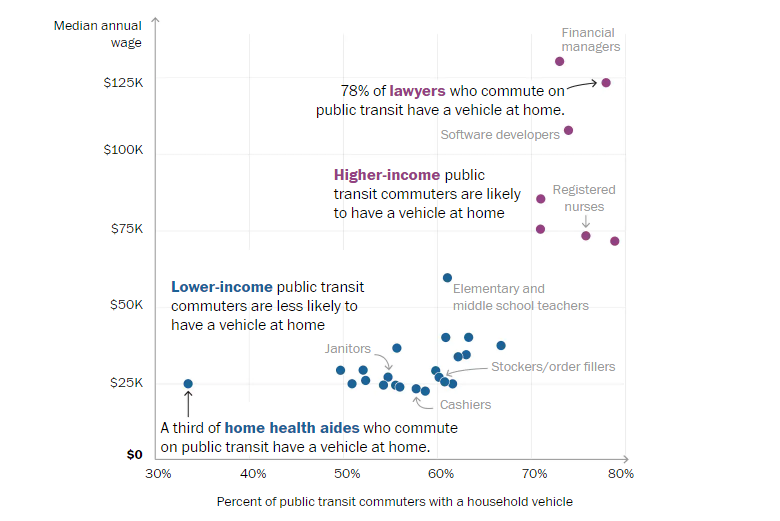
Percent of public transit commuters with a household vehicle
While reliance on public transit certainly is not the only reason these groups and occupations are most at risk during the pandemic, it is a lens into deeper issues that have plagued the same communities for decades.
Marla Nelson, a professor of planning and urban studies at the University of New Orleans, said these problems are part of why New Orleans has been hit so hard. “[It’s] the inequities that we had for decades before the outbreak, and the fact that we have huge levels of inequality and poverty and folks that lack access to health care.”
What does this mean for the future of urban transportation?
Experts were quick to note it is too soon to draw specific conclusions about the aftermath of the pandemic, but there are a few broad trends that could become likely.
In the immediate aftermath, systems will continue to implement methods to help maintain social distancing and cleanliness. The D.C. metro, for example, will maintain reduced service and try to limit passengers on buses and rail cars. Metrobus riders will also continue to board through the rear doors and ride free, as collecting fares would expose bus operators to passengers.
But the financial costs of reduced service remain a looming question for transit agencies. Losses, possibly into the billions, could reverberate for months or even years into the future.

Metro ridership in D.C. is down currently as the coronavirus changes day to day life and work patterns. (Matt McClain/The Washington Post)
“You’re seeing the financial vulnerability of transit agencies really laid bare for all of us to see,” Johnson said.
The impact of decreased ridership may be uneven across different public transportation systems. Railroads, for instance, are largely used by workers in professional, scientific and technical services who may be slow to return to commuting because they can work from home. In contrast, buses are more likely to be used by retail, health care and food service workers who must do their jobs in person.
Railroads may feel the pinch if white-collar workers continue to work from home
Percent of all public transit commuters in selected industries
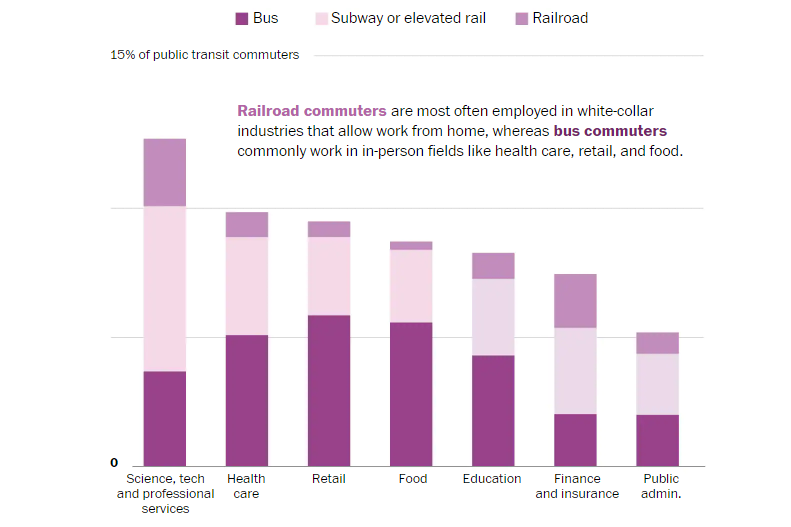 [In a week, the coronavirus razed U.S. transit and rail systems]
[In a week, the coronavirus razed U.S. transit and rail systems]
As we move further into the future, it is also likely that residents will begin to rely heavily on walking and cycling. Harvey said that is especially true for cities like New York City, which cannot accommodate more vehicular traffic. But the shift could still cause a strain on cities as more pedestrians take to the sidewalks.
“That’s going to place an additional burden on the streets,” she said. “We have to be thinking now, as we’re just starting to open up our cities again, how we can respond to these changes in behavior that are going to be happening at a massive scale.”
Seattle is one city that has already moved forward with that in mind. On Thursday, Mayor Jenny Durkan announced 20 miles of residential streets would be permanently closed to vehicular traffic.
As some cities and states slowly begin the process of reopening, experts emphasize that issues of inequality will need to be at the forefront of administrators’ minds. While there are a variety of issues at hand that impact inequities, public transportation and the covid-19 outbreak shine a light on how many of them interact.
“That’s what makes me and others very sad and very angry, talking about the harm that’s being done to people,” Bierbaum said. “We’re talking about death. We’re talking about driving people more deeply into poverty. The level of inhumanity around this is just so painful.”
About this story
Commuter transportation mode and income data sourced from the U.S. Census Bureau. Work-from-home estimates sourced from the American Time Use Survey. Income by detailed occupation sourced from the Bureau of Labor Statistics. Data on vehicle ownership, transit method by industry and transit use by detailed occupation/industry sourced from the U.S. Census Bureau via IPUMS USA at the University of Minnesota.
By Shelly Tan , Alyssa Fowers , Dan Keating and Lauren Tierney
May 15, 2020
| The text being discussed is available at
and
| |

